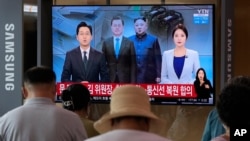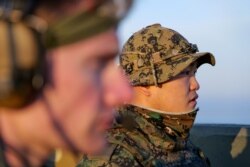In June, North Korean leader Kim Jong Un ordered his country to prepare for both “dialogue and confrontation” with the United States. It didn’t take long for the U.S. and its ally South Korea to experience both sides of that directive.
Two weeks ago, North Korea hinted it was open to more interaction with the outside world. But this week it lashed out at Seoul and Washington for conducting annual joint military exercises — a lightning-quick about-face, even by the volatile standards of North Korea.
On Wednesday, Kim Yong Chol, a senior North Korean general and politician, warned Washington and Seoul will face a “serious security crisis” because of their “wrong choice” in holding the drills.
“They must be made to clearly understand how dearly they have to pay for answering our good faith with hostile acts after letting go the opportunity for improved inter-Korean relations,” said Kim, according to state media.
A day earlier, Kim Yo Jong, the influential sister of North Korean leader Kim Jong Un, called the South Korean decision “perfidious,” saying the drills show the need for North Korea to advance its “powerful preemptive strike” capabilities.
In apparent protest of the drills, North Korea also refused to answer South Korea’s phone calls through a pair of recently reconnected inter-Korean hotlines on Tuesday and Wednesday.
Though North Korea blames Washington and Seoul for escalating tensions, the North’s strategy isn’t new. For years, Pyongyang has used both threats and the prospect of talks to pressure Washington and Seoul, analysts say.
“[It’s] the old playbook,” said Rachel Minyoung Lee, a Seoul-based Korea specialist at the Stimson Center. “We’ve seen this type of behavior from North Korea too much.”
Detente crumbling?
Some in Seoul were optimistic last month, when both Koreas announced that Kim Jong Un and South Korean President Moon Jae-in had recently exchanged letters.
It appeared to be the highest level inter-Korean dialogue in nearly two years, and many hoped it would serve as a precursor toward better U.S.-North Korea ties.
As a first step toward improving inter-Korean relations, both leaders decided to reconnect several hotlines that the North had severed a year earlier during a previous outburst.
But even then, there were signs that North Korea was hedging.
Though outward-facing North Korean state media hailed the hotline restoration as a “big stride” toward restoring mutual trust, the article was never published domestically, an indication the North was never wholly committed to the idea of engaging the South, Lee said.
“It was clearly watching South Korea’s handling of the scheduled joint drills,” she added.
Pressure point
North Korea regularly warns the South against holding the annual drills and often uses the occasion as a pressure point on Seoul.
This time around, the heat was especially intense for Moon, who has less than a year in office and wants to leave a legacy of inter-Korean cooperation.
“I’m sure he doesn’t want to leave office with inter-Korean relations in this kind of state,” Lee said. “North Korea was one of his top priorities, as we all know.”
But Moon must hold the drills to advance another of his key goals: the transfer of wartime operational control of the South Korean military from the U.S. to South Korea.
Under the current setup, the U.S. would control the South Korean military if war broke out. Moon has said he would like to change that arrangement by the time he leaves office.
But the transfer is not supposed to take place unless numerous benchmarks are met, including South Korea’s performance during military exercises.
Scaled back drills
The U.S. and South Korea have for years scaled back or canceled major military drills, first in an effort to preserve the chances for diplomacy and later because of the pandemic.
This month’s exercises will involve fewer personnel than normal because of the coronavirus, according to several South Korean reports.
The current exercises are computer-based command post exercises, in which teams react to simulated incidents.
David Maxwell, a senior fellow who focuses on Korea at the Foundation for Defense of Democracies, says such drills are crucial.
“They are the Ph.D. level of defense training because they can provide the full range of complex scenarios,” Maxwell said.
Defensive drills
But no matter their size or scope, North Korea views the drills as an act of aggression, Kim Yo Jong said in her statement this week.
In a regular briefing Tuesday, U.S. State Department spokesperson Ned Price pushed back on that assertion, saying the exercises are “purely defensive in nature.”
“We have made that point repeatedly, and it’s a very important one,” Price said.
“More broadly, and as we’ve said in recent weeks, we support inter-Korean dialogue. We support inter-Korean engagement, and we’ll continue to work with our (South Korean) partners towards that end,” he added.
What’s next?
Much depends on North Korea’s next move.
While Pyongyang has hinted at more tensions, its statements this week did not carry specific threats.
Officials with South Korea’s spy agency recently told lawmakers in Seoul they expect North Korea could soon test a submarine-launched ballistic missile.
But Lee says the North may be more likely to start with a less risky provocation, such as dissolving North Korean government organizations that handle inter-Korean cooperation.
At the beginning of 2020, Kim Jong Un warned he will no longer be bound by his self-imposed moratorium on long-range missile launches or nuclear tests.
But North Korea may be reluctant to take any step that risks bringing further economic and diplomatic isolation.
North Korea is already dealing with economic hardship caused by its severe coronavirus lockdown, as well as several natural disasters that have hurt its agriculture
Leif-Eric Easley, a professor at Ewha University in Seoul, says those pressures may help explain North’s latest shift.
“North Korea’s amped up rhetoric against scaled down U.S.-South Korea defense exercises appears to be more about domestic politics than signaling to Washington,” he said. “The Kim regime is shifting blame for its struggles to restart the economy after a long, self-imposed pandemic lockdown.”







